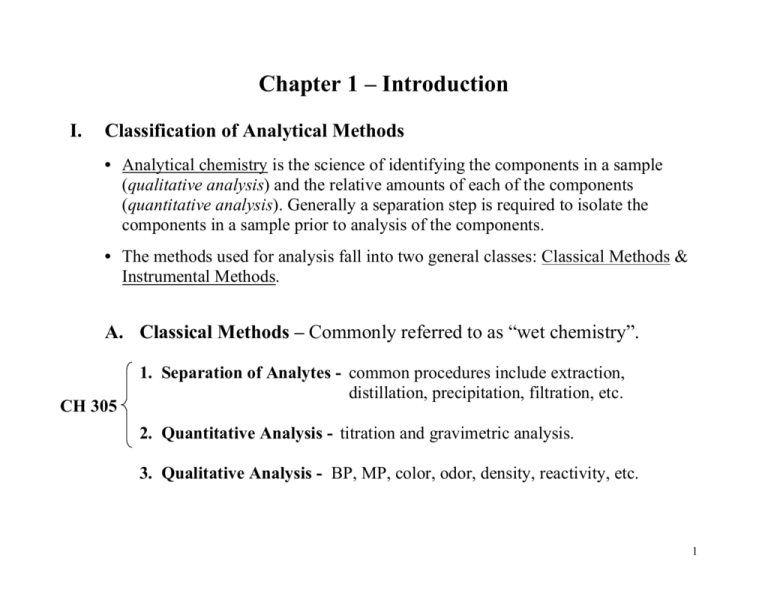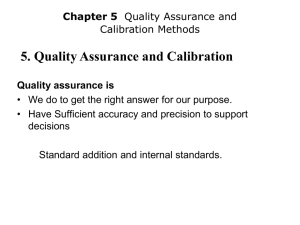Chapter1_notes
advertisement

Chapter 1 – Introduction I. Classification of Analytical Methods • Analytical chemistry is the science of identifying the components in a sample (qualitative analysis) and the relative amounts of each of the components (quantitative analysis). Generally a separation step is required to isolate the components in a sample prior to analysis of the components. • The methods used for analysis fall into two general classes: Classical Methods & Instrumental Methods. A. Classical Methods – Commonly referred to as “wet chemistry”. CH 305 1. Separation of Analytes - common procedures include extraction, distillation, precipitation, filtration, etc. 2. Quantitative Analysis - titration and gravimetric analysis. 3. Qualitative Analysis - BP, MP, color, odor, density, reactivity, etc. 1 B. Instrumental Methods - exploit the physical properties of an analyte to obtain qualitative and quantitative information. 2 1. Separation of Analytes - can be accomplished in two ways a. Physical separation of analytes. i. Chromatography - gas or liquid (GC, LC) ii. Electrophoresis - gel or capillary gel electrophoresis (GE, CGE) b. Spectroscopic separation of the analyte. • Isolate the signal arising from the analyte in a sample using a spectrophotometer. 2. Quantitative Analysis • Ultraviolet-Visible spectrophotometry (UV-Vis) • Atomic emission and absorption spectroscopy (AES, AAS) • Conductivity (pH, ISE) 3. Qualitative Analysis • X-ray spectrometry • Infrared spectroscopy (IR) • Mass Spectrometry (MS) • Nuclear magnetic resonance (NMR) 3 II. Instrument components General instrument schematic Analytical Signal Signal Generator Detector or Input Transducer Transduced Signal Electrical or Mechanical Signal Signal Processor Display Unit Computer Digital Readout Digital Data Chart Recorder Meter Analog Data 4 III. Selecting an Analytical Method A. Defining the Problem • It is important to talk to sample submitter and determine the best means of analysis. 1. What accuracy is required? 2. How much sample is available? 3. What is the concentration range of the sample? 4. Are there components in the sample that will cause interferences? 5. What are the physical and/or chemical properties of the matrix? 6. How many samples are to be analyzed? 5 B. Performance Characteristics & Figures of Merit • Performance Characteristics - criteria used to compare which of several instrumental methods would be the best for a particular analysis. • Figures of Merit - quantitative (numerical) measures of performance characteristics. • Typical performance characteristics used to select an analytical method: 1) Precision 2) Bias 3) Detection Limit 4) Dynamic Range 5) Selectivity • Other characteristics to consider when choosing an analytical method: 1) Speed of analysis 2) Ease & convenience 3) Operator skill level 4) Cost and availability of equipment (instrumentation) 5) Cost of analysis per sample 6 1. Precision - measure of the reproducibility of a set of determinations. Figures of merit: a) Absolute estimated standard deviation (s) xi x s 2 N 1 or s xi 2 2 x i N N 1 s = absolute standard deviation xi = individual determination x = mean value of determinations N = number of determinations b) Relative standard deviation (RSD) RSD s x c) Coefficient of variation (CV) CV s 100 x 7 2. Bias - measure of the systematic, or determinate, error in an analytical analysis. Figures of merit: a) Absolute bias, or error (Ea) Ea x x = mean of a small (sample) set of replicate measurements = true or accepted value b) Relative bias, or error Relative Error x c) Percent bias, or error % Error x 100 8 3. Sensitivity - the ability to discriminate between small differences in analyte concentration. Figures of merit: a) Calibration sensitivity (m)** S mc S bl Signal (S ) S = signal or instrument response Sbl = signal from blank sample c = sample concentration m = calibration sensitivity (slope of calibration curve) 100 m2 80 60 Sm2 40 Sm1 20 Sbl m1 0 0 0.2 0.4 0.6 0.8 1 Concentration (c ) ** b) Analytical sensitivity () IUPAC definition m sS = analytical sensitivity m = calibration sensitivity sS = std. dev. in signal measurement 9 4. Detection Limit - the minimum concentration or mass of analyte that can be detected by an instrumental method at a known level of confidence (usually 95% confidence level). Figures of merit: a) Minimum detectable signal (Sm) S m S avg,bl ksbl Sm = minimum detectable signal Savg,bl = average signal of the blank sbl = standard deviation in the blank signal k = multiple of variation in the blank signal - The analytical signal must be larger that the blank signal (Savg,bl) by some factor (k) of the standard deviation in the blank (sbl). k is usually set to a value of three. b) Minimum detectable concentration (cm) - Limit of Detection (LOD) cm S m S avg, bl m cm = minimum detectable concentration m = slope of the calibration curve - Expressed in terms of sbl cm ksbl m 10 5. Dynamic Range - the range for an analytical method which extend form the lowest concentration at which a quantitative measure can be made (LOQ) to the concentration at which the calibration curve departs from linearity (LOL). Instrument Response LOL LOQ cm Dynamic Range Concentration Figures of merit: a) Limit of quantitation (LOQ) LOQ 10sbl m sbl = standard deviation in the blank signal m = slope of the calibration curve a) Limit of linearity (LOL) – point where the calibration curve departs from linearity. (somewhat arbitrary) 11 6. Selectivity - the degree to which an analytical method is free from interferences from other species contained in the sample matrix. - Selectivity coefficients are not widely use to compare different methods of analysis. 12 Example: A calibration curve is determined for lithium (Li) using flame atomic emission spectroscopy. The slope of the calibration curve is 1221 emission units per concentration unit (g/mL, ppm). Five replicate blank analyses resulted in the following instrument responses for the blank: 54, 61, 57, 60, 57 emission units. A) What is the calibration sensitivity of the method? B) What is the limit of detection for the method? C) What is the limit of quantitation for the method? 13 IV. Calibration of Instrumental Methods Calibration – the process of relating the measured analytical signal (instrument response) to the concentration of the analyte. Common methods of calibration: A. Preparation of a calibration curve. B. Standard addition method. C. Internal standard method. 14 A. Calibration Curves • Several standards of known analyte concentrations are prepared, introduced into the instrument, and instrument response (absorbance, emission, pH, etc.) is recorded. • Standard Solutions – Solutions of known analyte concentrations usually prepared by the experimenter. The standards are prepared over a concentration that encompasses the expected concentration of the analyte, but not beyond the LOL for the instrument. • Calibration Curve – A plot of standard concentration (x) vs. instrument response (y). Preferably the relationship between standard concentration and instrument response is linear. 15 1. Preparation of Calibration Curves • Plot standard concentration vs. instrument response. Calibration Curve Corrected IR 2.5 2.0 1.5 1.0 0.5 0.0 0 20 40 60 80 100 Concentration Concentration 0.000 6.010 31.800 63.500 88.900 Blank Sample Instrument Response (IR) 0.013 0.101 0.811 1.498 2.094 0.049 0.924 Corrected IR 0.000 0.088 0.798 1.485 2.081 0.875 16 • Use least squares method (linear regression) to calculate equation for best fit line (y = mx + b). Mean xi Concentration 0.000 6.010 31.800 63.500 88.900 190.210 38.042 IR 0.013 0.101 0.811 1.498 2.094 S xx xi x 2 xi2 yi Corr. IR 0.000 0.088 0.798 1.485 2.081 4.452 0.890 2 xi x i2 y i2 xiyi 0.000000 36.120100 1011.240000 4032.250000 7903.210000 12982.820100 0.000000 0.007744 0.636804 2.205225 4.330561 7.180334 0.000000 0.528880 25.376400 94.297500 185.000900 305.203680 S yy y i y 2 N S xy xi x y i y xi y i m S xy S xx (Slope) r xi y i y i2 2 yi N N b y -x m (Y - intercept) S xy S xx S yy 17 2. Interpretation of Calibration Curves • Use the equation for the line (y = mx + b) to calculate the concentration of the standard. m = 0.0236 & b = -0.00881 y = 0.0236x – 0.00881 Where: y = Corrected Instrument Response x = Sample Concentration Rearrange: x = (y – b)/m x = (y + 0.00881)/0.0236 And: x(sample concentration) = 37.4 18 B. Method of Standard Additions • Used for analytes in a complex matrix where interferences in the IR for the analyte will occur. i.e. blood, sediment, human serum, etc. • Often referred to as Spiking the sample. • Method: (1) Prepare several identical aliquots, Vx, of the unknown sample. (2) Add a variable volume, Vs, of a standard solution of known concentration, cs, to each unknown aliquot. (3) Dilute each solution to an equal volume, Vt. (4) Make instrumental measurements of each sample to get an instrument response, IR. (5) Calculate unknown concentration, cx, from the following equation. Note: This method assumes a linear relationship between instrument response and sample concentration. 19 • Standard Additions Equation kVs cs kVx cx S Vt Vt Where: S = signal or instrument response k = proportionality constant Vs = volume of standard added cs = concentration of the standard Vx = volume of the sample aliquot cx = concentration of the sample Vt = total volume of diluted solutions 20 • A plot of instrument response (S) vs. standard volume (Vs) yields a straight line of the form: Instrument Response (S ) m = y/ x b = y-intercept (V s ) 0 Vs S mVs b 21 • Calculating concentration of the sample. kVs cs kVx c x S Vt Vt S mV s b and Therefore: kcs m Vt b and kVx cx Vt kVx cx Vt Vx cx b kcs m cs Vt so bcs cx mVx 22 Example: Standard Additions Method Arsenic in a biological sample is determined by the method of standard additions. 10-mL aliquots of the sample are pipetted into each of five 100-mL volumetric flasks. Various volumes of a 22.1 ppm As standard were added to four of the five flask and each solution was diluted to volume with deionized water. The absorbance of each solution was determined. Sample (mL) Standard (mL) Absorbance 10.0 10.0 10.0 10.0 10.0 0.00 5.00 10.00 15.00 20.00 0.156 0.195 0.239 0.276 0.320 Calculate the concentration of the sample and its standard deviation. 23 Arsenic Standard Addition 0.45 0.40 m = 0.00818 b = 0.1554 sm = 0.000119 sb = 0.001463 Absorbance 0.35 0.30 0.25 0.20 0.15 0.10 0.05 0.00 0 5 10 15 20 Volume Standard (V s) 24 • Using Standard Addition to estimate sample concentration 1) Make two solutions containing equal aliquots of sample and add standard to one of the solutions. Dilute solutions to volume. 2) Measure instrument response for both solutions. 3) Calculate the concentration of the sample with the following equation. cx S1csVs S2 S1 Vx Where: S1 = instrument response sample S2 = instrument response sample + standard 25 Example: Two-point Standard Addition A 25.0-mL aliquot of an aqueous quinine solution was diluted to 50.0 mL and determined to have an absorbance of 0.416 at 348 nm when measured in a 1.00 cm cell. A second 25 mL aliquot was mixed with 10.0 mL of a solution containing 23.4 ppm of quinine. After diluting the solution to 50.0 mL, this solution had an absorbance of 0.610 (1.00 cm cell). Calculate the concentration (ppm) of quinine in the sample. 26







